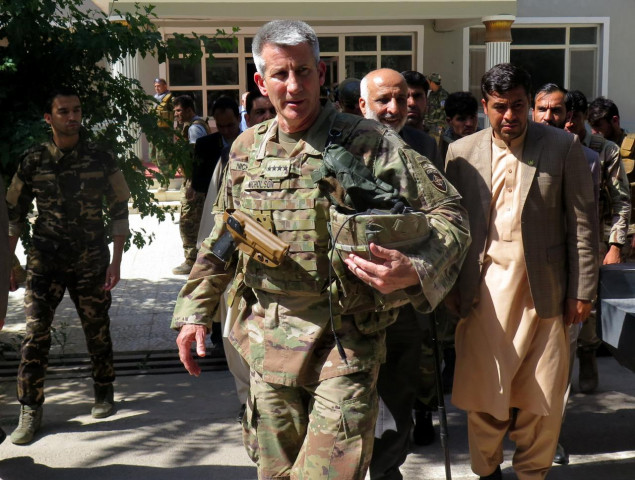Taliban 'talking and fighting,' says US commander in Afghanistan
Critics warn US-backed Afghan army cannot promise to defeat Taliban or overcome Afghanistan’s vast political...

PHOTO REUTERS
“You see mid-level, senior-level Taliban leaders engaging with Afghans,” said Army General John Nicholson, adding that a lot of the diplomatic activity was taking place “off the stage.”
Nicholson’s remarks came the same day that gunmen armed with assault rifles and grenade launchers attempted to penetrate the heavily fortified headquarters of the Afghan interior ministry, battling security forces for more than two hours in the latest attack on the capital Kabul.
Taliban openly active in 70 per cent of Afghanistan, reveals BBC study
The attack was a reminder of the challenges facing US-backed Afghan forces even after 16 years of war, including in the capital Kabul. Last month, two explosions in Kabul killed at least 26 people, including nine journalists.
Nicholson said initial indications suggested Taliban and the Haqqani network were behind the attack, even though Islamic State claimed responsibility.
In his remarks to Pentagon reporters, Nicholson sought to underscore data and events he said point to forward progress in America’s longest war. Critics warn the US-backed Afghan army cannot promise to defeat the Taliban or overcome Afghanistan’s vast political divisions and entrenched corruption.
More than 2,400 US forces have died in the conflict.
Nicholson pointed to unreleased data showing a 30 per cent decline in attacks initiated by the insurgents between February and April, compared with the average over the previous five years. Attacks increased after the Taliban announced their spring offensive on April 25 but the violence was still 10 to 12 per cent lower, he said.
US officials in recent years have declined to offer data on levels of attacks initiated by insurgents, saying that the United States no longer had a big enough intelligence gathering operation in Afghanistan to publish reliable estimates.
Taliban attack kills six police in southern Afghanistan
Nicholson acknowledged much of his data drew upon the Afghan government’s estimates, which the US government has long considered less reliable. But when pressed during the news briefing, Nicholson said he was still confident in the trend suggested by the data.
“If this were a matter of a few percentage points, I’d have less confidence,” he said.
He also drew comparisons to Colombia, where insurgents from the Revolutionary Armed Forces of Colombia (FARC) and government forces were fighting before a 2016 peace agreement.
Still, many experts say there are huge differences between the Colombian and Afghan conflicts.
“The idea that we’re making the same kind of progress (as in Colombia) is grasping at straws for justification,” said Jason Dempsey, an adjunct senior fellow at the Center for New American Security think-tank who deployed twice to Afghanistan.
Nicholson highlighted a grassroots “peace movement,” which he said was not aligned to any party in Afghanistan’s nearly 17-year-old conflict. He said it has held events in 20 Afghan provinces, calling for ceasefires and peace talks.
“And this has never happened before in Afghanistan, to my knowledge, over 20 provinces,” he said.
Asked about how this would affect the US mission in Afghanistan, Nicholson said: “The end state of the policy is to achieve a reconciliation.”


















COMMENTS
Comments are moderated and generally will be posted if they are on-topic and not abusive.
For more information, please see our Comments FAQ